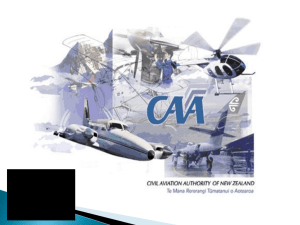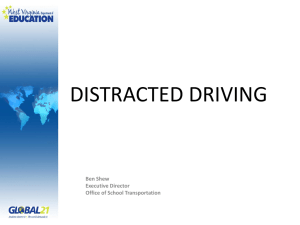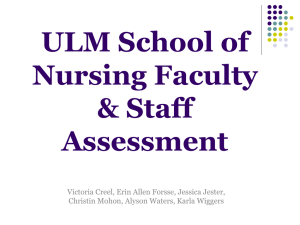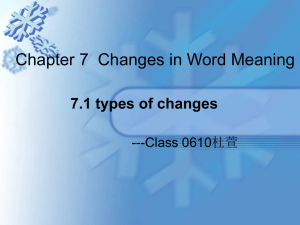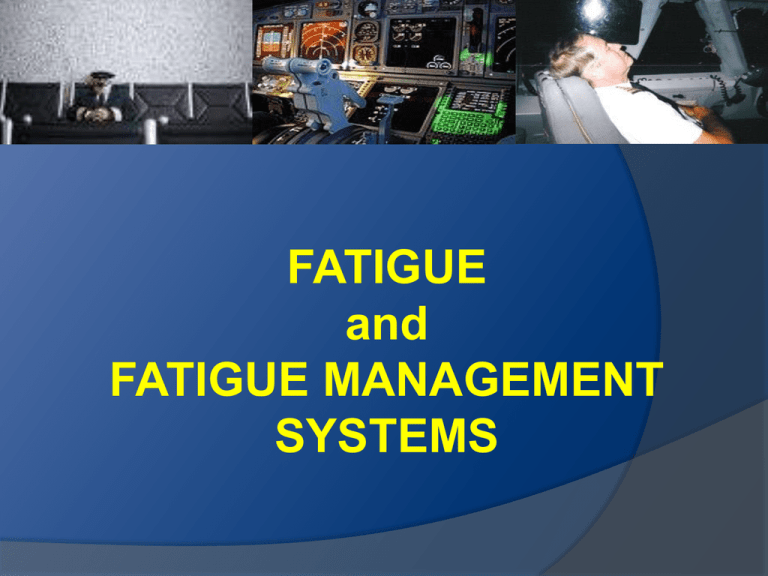
FATIGUE
and
FATIGUE MANAGEMENT
SYSTEMS
TOPICS
-
The Nature of fatigue in flight operations
Traditional Fatigue Management Systems
The Fatigue Risk Management System
Fatigue in Human Factors Training
FATIGUE
The
average population is awake for
16 hours a day and sleeps for 8 hours
Where
less than 8 hours is obtained,
or sleep is disrupted, the body starts
to enter a state of fatigue
FATIGUE
Like food and water, sleep is a physiological
need vital to human survival and critical to human
existence. Sleep loss can be additive and can
result in a cumulative sleep debt.
If we were to sleep for 2 hours per night less than
we needed, then after four nights, our fatigue
state would be similar to having had no sleep.
The performance degradation after a single night
without sleep can be quite astonishing
FATIGUE
Sleep loss and fatigue can decrease physical,
psychomotor, and mental performance, and can
affect mood.
A principal consequence of fatigue is an increased
vulnerability to performance decrements.
Like the effects of alcohol on performance,
judgement and memory, fatigue can lead to a
reduced safety margin and an increased potential
for operational incidents and accidents.
FATIGUE
Sleep
loss and fatigue resulting from
extended duty or altered work/rest
schedules have been suggested as
contributory factors in many accidents and
catastrophes.
Chernobyl
Exxon Valdez
Flying Tigers (Kuala Lumpur)
Korean Airlines (Guam)
American Airlines (Little Rock)
FATIGUE
Sleep
is a highly complex physiological
process during which the brain and body
alternate between periods of extreme
activity and quiet.
It is composed of two distinct states:
REM
- Rapid Eye Movement sleep
NREM - Non-REM Sleep
FATIGUE
During NREM sleep, physiological and mental activities
slow (e.g., heart rate and breathing rate slow and become
regular).
NREM sleep is divided into four stages, with the deepest
sleep occurring during stages 3 and 4. There is usually
very little mental activity during NREM stages 3 and 4.
If awakened during this deep sleep, an individual may
take some time to wake up and then continue to feel
groggy, sleepy, and perhaps disoriented for 10-15
minutes. This phenomenon is called sleep inertia.
FATIGUE
REM sleep is associated with an extremely active
brain that is dreaming, and with bursts of rapid
eye movements (probably following the activity of
the dream)
During REM sleep, the major motor muscles of
the body are paralysed, although some twitching
may occur.
If awakened during REM sleep, individuals can
often provide detailed reports of their dreams.
FATIGUE
(Dawson, 2006)
FATIGUE
Factors Affecting Sleep
Prior sleep/wakefulness
Age (much less REM as you get older)
Medical conditions (eg. Apnoea, Twitching Leg)
Medications
Alcohol
Environmental/work conditions
Time Zone Passage
Circadian phase
The Circadian Rhythm
FATIGUE
Trans-Meridian Passage
When we transit across time zones the circadian cycle is
either artificially shortened or lengthened, depending on
whether we travel East or West.
It can often take several days for the body to
resynchronise to the new time zone, so we may naturally
feel like not going to sleep when we should, or
alternatively, sleeping at inappropriate times
It can have substantial effects on the amount and quality
of our sleep until the body adjusts to the new time zone
FATIGUE
Fatigue affects us in the following ways:
Forgetfulness and unreliable memory
Reduced cognitive ability
Loss of flexibility
Poor decision making (especially unbounded decisions)
Slowed reaction time and decreased ability to perform skills
Reduced attention and vigilance / fixation
Poor communication (a fundamental core of CRM)
Reduced situational awareness
Apathy and lethargy (can’t be bothered)
Bad mood (affects crew cooperation and teamwork)
Nodding off / microsleeps
Physical fatigue (Cabin Crew on their feet all day)
FATIGUE
The following graphs show the results of some
experiments on fatigue from the University of
South Australia Sleep Research Centre.
They compare the effects of sleep deficit with the
effects of alcohol
FATIGUE
Effects of fatigue:
(Dawson, 2006)
FATIGUE
Effects of fatigue:
(Dawson, 2006)
FATIGUE
Effects of fatigue:
(Dawson, 2006)
SYMPTOMS OF FATIGUE
PHYSICAL SYMPTOMS
MENTAL SYMPTOMS
• Yawning
• Heavy eyelids
• Eye-rubbing
• Head drooping
• Microsleeps
• Difficulty concentrating
on tasks
• Lapses in attention
• Difficulty remembering
what you are doing
• Failure to
communicate
important information
• Failure to anticipate
events or actions
• Accidentally doing the
wrong thing
• Accidentally not doing
the right thing
EMOTIONAL SYMPTOMS
• More quiet or
withdrawn than
normal
• Lacking energy
• Lacking motivation
to do the task well
• Irritable or grumpy
behaviour
Countermeasures
Low fat, high protein; fruits and vegetables; whole-grain breads and
cereals
At least 2 litres of water per day
Regular exercise
Long naps, 3-4 hours, can significantly restore alertness for 12-15 hrs
Short or “power” naps of 10-30 minutes can help restore alertness for
3-4 hours.
Caffeine can help counteract noticeable fatigue symptoms if awake for
18 hours or less
Rotate flight tasks and converse with other crewmembers
Keep the flight deck temperature cool
Move / stretch in the seat, and periodically get up to walk around the
aircraft if possible
Gradually shift times for sleep, meals, and exercise to adjust to a new
time zone
Countermeasures
Wake-up and go to bed at the same time every day to avoid circadian
disruptions.
Use the bedroom only for sleep and sex and not for work.
Establish a consistent and comforting bedtime routine (i.e., reading,
taking a hot shower, and then going to bed).
Perform aerobic exercise every day, but not within 2 h of going to bed.
Make sure the bedroom is quiet, totally dark, and comfortable.
Keep the sleep environment cool (16–18°C if you are covered).
Move the alarm clock out-of-sight so you cannot be a clock watcher.
Avoid caffeine in drinks and other forms during the afternoons/evenings.
Do not use alcohol as a sleep aid (it may make you sleepy, but you will
not sleep well).
Avoid cigarettes or other sources of nicotine right before bedtime.
Do not lie in bed awake if you do not fall asleep within 30 minutes
Traditional Fatigue Management Systems
Generally speaking FMS have been based
on prescribed hours of service.
These are often laid out or suggested by
regulatory authorities, or in negotiated
employment agreements.
Common examples include:
CASA CAO 48.1
NZCAA AC 119-2
UKCAA CAP 371
EU – OPS 1 FTL
FAA FAR PART 121
CASA CAO 48.1
NZCAA AC 119-2
UKCAA CAP 371
THE FATIGUE RISK
MANAGEMENT SYSTEM
FRMS
The concept of “defences in depth”
stems from the work of James
Reason (1997), and applies to the
original battlefield philosophy of
multiple lines of different types of
defences to the process of safety
management.
According to this model, the most
effective way that an organisation
can manage a specific hazard, is
through the development of multiple
layers of defences.
FRMS
Rather than relying on compliance with
prescriptive hours of service (HOS) rulesets in order to manage the safety-related
risks of fatigue, an FRMS develops and
employs multiple strategies to manage
fatigue, such that each strategy forms an
additional layer of defence against fatigue.
Multiple Defences against a Fatigue as an Identifiable Hazard (Dawson and McCulloch, 2005)
Self Assessment –
Individual Fatigue Likelihood Scorecard (IFLS)
FATIGUE ASSESSMENT
STEP 1: Sleep in prior 24 hours
Sleep
≤ 2h 3h 4h 5+h
Points
12 8
4
0
STEP 2: Sleep in prior 48 hours
Sleep
≤ 8h 9h 10h 11h 12+h
Points
8
6
4
2
0
STEP 3: Hours awake since last sleep (at end of shift)
If sleep in Step 2 is greater than hours awake, points = 0.
If less, add 1 point per hour awake greater than sleep in Step 2.
SCORE
Example
AKL – RAR RTN
1815 – 0530 Duty
8 hours sleep last night
4 hours sleep previous night
Wake up at 0730
Total points to determine your score
WHAT ACTION DO I TAKE?
SCORE
CONTROL LEVEL
1-4
Keep an eye on yourself
5-8
Look out for each other
9+
Go back to bed
STEP 1 = 0
STEP 2 = 0
STEP 3 =10
TOTAL = 10
Go Back to Bed!
BEHAVIOURAL MONITORING
KEEP AN EYE ON YOURSELF
LOOK OUT FOR EACH OTHER
• Monitor your alertness
• Look for symptoms of fatigue
• Consider use of in-flight rest
where available
• Look at food intake and
hydration
• Consider use of caffeine
• Exposure to light may improve
alertness
• Communicate your state to
other crewmembers
• Assess your ability for duty
• Find an opportunity for rest
when available
•Cabin Crew consider
reallocation of positions
and service tasks
• Flight Crew consider PF / PM
• Submit a Fatigue Report Form
FRMS
Within the VB / PB FRMS there are
three groups set up to oversee and run
the FRMS:
The Roster Working Group Committee
The Crew Alertness Study Team
The Governance Committee
Human Factors
Training Implications
Like Stress, Fatigue has an adverse effect on
every other facet of human factors eg.
-
Communication
Cooperation / Teamwork
Workload Management
Information Processing
Decision Making
Situational Awareness
Leadership
Human Factors
Training Implications
Individual companies will make their own choices
over what fatigue management scheme they
elect to employ, however as Human Factors
facilitators and developers it is important for us to
recognise the criticality of fatigue and to do our
best to enhance crew awareness of:
Fatigue effects
Behavioural signs of fatigue, and
Fatigue countermeasures
Questions?

